Victor Hugo
Victor Marie Hugo (French: [viktɔʁ maʁi yɡo] (![]()
Victor Hugo Peer of France (1845–1848) | |
|---|---|
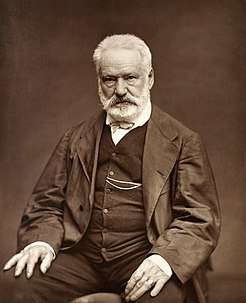 Woodburytype of Hugo by Étienne Carjat, 1876 | |
| Senator of Seine | |
| In office 30 January 1876 – 22 May 1885 | |
| Constituency | Paris |
| Member of the National Assembly for Gironde | |
| In office 9 February 1871 – 1 March 1871 | |
| Constituency | Bordeaux |
| Member of the National Assembly for Seine | |
| In office 24 April 1848 – 3 December 1851 | |
| Constituency | Paris |
| Member of the Académie française | |
| In office 7 January 1841 – 22 May 1885 | |
| Preceded by | Népomucène Lemercier |
| Succeeded by | Leconte de Lisle |
| Personal details | |
| Born | Victor Marie Hugo 26 February 1802 Besançon, Doubs, France |
| Died | 22 May 1885 (aged 83) Paris, France |
| Resting place | Panthéon, Paris |
| Nationality | French |
| Political party | Party of Order (1848–51) Independent liberal (1871) Republican Union (1876–85) |
| Spouse(s) | Adèle Foucher (m. 1822; died 1868) |
| Children |
|
| Parents | Joseph Léopold Sigisbert Hugo Sophie Trébuchet |
| Education | Lycée Louis-le-Grand |
| Occupation | Writer, poet, journalist, drawer |
| Writing career | |
| Genre | Novel, dramaturgy, theatre, poetry |
| Literary movement | Romanticism |
| Notable works |
|
| Years active | 1829–1883 |
| Signature | |
| French literature |
|---|
| by category |
| French literary history |
|
| French writers |
|
| Portals |
|
Hugo was at the forefront of the Romantic literary movement with his play Cromwell and drama Hernani. Many of his works have inspired music, both during his lifetime and after his death, including the musicals Les Misérables and Notre-Dame de Paris. He produced more than 4,000 drawings in his lifetime, and campaigned for social causes such as the abolition of capital punishment.
Though a committed royalist when he was young, Hugo's views changed as the decades passed, and he became a passionate supporter of republicanism; his work touches upon most of the political and social issues and the artistic trends of his time. He is buried in the Panthéon in Paris. His legacy has been honoured in many ways, including his portrait being placed on French currency.
Personal life
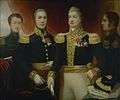 Joseph Hugo with two of his brothers and his son Abél
Joseph Hugo with two of his brothers and his son Abél Hugo's maternal grandmother, Renée-Louise Trébuchet
Hugo's maternal grandmother, Renée-Louise Trébuchet Hugo's maternal grandfather, Jean-François Trébuchet
Hugo's maternal grandfather, Jean-François Trébuchet
Victor Hugo was the third son of Joseph Léopold Sigisbert Hugo (1774–1828) and Sophie Trébuchet (1772–1821) who was descended from the inventor the trébuchet; his brothers were Abel Joseph Hugo (1798–1855) and Eugène Hugo (1800–1837). He was born in 1802 in Besançon in the eastern region of Franche-Comté. On 19 November 1821, Léopold Hugo wrote to his son that he had been conceived on one of the highest peaks in the Vosges Mountains, on a journey from Lunéville to Besançon. " This elevated origin, he went on, seems to have had effects on you so that your muse is now continually sublime."[1] Hugo believed himself to have been conceived on 24 June 1801, which is the origin of Jean Valjean's prisoner number 24601.[2]
Léopold Hugo was a freethinking republican who considered Napoleon a hero; by contrast, Sophie Hugo was a Catholic Royalist who was intimately involved with her possible lover Géneral Victor Lahorie,[3] who was executed in 1812 for plotting against Napoléon.
Hugo's childhood was a period of national political turmoil. Napoléon was proclaimed Emperor of the French two years after Hugo's birth, and the Bourbon Monarchy was restored before his 13th birthday. The opposing political and religious views of Hugo's parents reflected the forces that would battle for supremacy in France throughout his life: Hugo's father was a high-ranking officer in Napoléon's army until he failed in Spain (one of the reasons why his name is not present on the Arc de Triomphe).
Because Hugo's father was an officer, the family moved frequently and Hugo learned much from these travels. On a childhood family trip to Naples, Hugo saw the vast Alpine passes and the snowy peaks, the magnificently blue Mediterranean, and Rome during its festivities.[4] Though he was only five years old at the time, he remembered the six-month-long trip vividly. They stayed in Naples for a few months and then headed back to Paris.
At the beginning of her marriage, Hugo's mother Sofi followed her husband to posts in Italy (where Léopold served as a governor of Avellino, a province near Naples) and Spain (where he took charge of three Spanish provinces). Weary of the constant moving required by military life and at odds with her husband's lack of Catholic beliefs, Sophie separated temporarily from Léopold in 1803 and settled in Paris with her children. Thereafter she dominated Hugo's education and upbringing. As a result, Hugo's early work in poetry and fiction reflect her passionate devotion to both king and faith. It was only later, during the events leading up to France's 1848 Revolution, that he began to rebel against his Catholic Royalist education and instead acted as a champion to Republicanism and Freethought.
Young Victor fell in love with and secretly became engaged to his childhood friend Adèle Foucher (1803–1868), against his mother's wishes. Because of his close relationship with his mother, Hugo waited until after her death (in 1821) to marry Adèle in 1822.
Adèle and Victor Hugo had their first child, Léopold, in 1823, but the boy died in infancy. On 28 August 1824, the couple's second child, Léopoldine was born, followed by Charles on 4 November 1826, François-Victor on 28 October 1828, and Adèle on 28 July 1830.
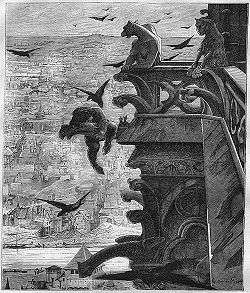
Hugo's eldest and favourite daughter, Léopoldïne, died aged 19 in 1843, shortly after her marriage to Charles Vacquerie. On 4 September, she drowned in the Seine at Villequier, pulled down by her heavy skirts when a boat overturned. Her young husband also died trying to save her. The death left her father devastated; Hugo was travelling with one of his many mistresses at the time in the south of France, and first learned about Léopoldine's death from a newspaper that he read in a café.[5]
He describes his shock and grief in his famous poem "À Villequier":
Hélas ! vers le passé tournant un œil d'envie,
Sans que rien ici-bas puisse m'en consoler,
Je regarde toujours ce moment de ma vie
Où je l'ai vue ouvrir son aile et s'envoler!
Je verrai cet instant jusqu'à ce que je meure,
L'instant, pleurs superflus !
Où je criai : L'enfant que j'avais tout à l'heure,
Quoi donc ! je ne l'ai plus !
Alas! turning an envious eye towards the past,
inconsolable by anything on earth,
I keep looking at that moment of my life
when I saw her open her wings and fly away!
I will see that instant until I die,
that instant—too much for tears!
when I cried out: "The child that I had just now—
Oh! I don't have her any more!"
He wrote many poems afterwards about his daughter's life and death, and at least one biographer claims he never completely recovered from it. His most famous poem is arguably "Demain, dès l'aube" (Tomorrow, at Dawn), in which he describes visiting her grave.
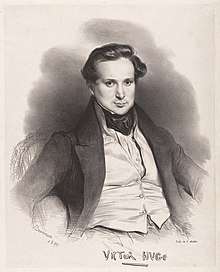
Hugo decided to live in exile after Napoleon III's coup d'état at the end of 1851. After leaving France, Hugo lived in Brussels briefly in 1851, and then moved to the Channel Islands, first to Jersey (1852–1855) and then to the smaller island of Guernsey in 1855, where he stayed until Napoleon III's fall from power in 1870. Although Napoleon III proclaimed a general amnesty in 1859, under which Hugo could have safely returned to France, the author stayed in exile, only returning when Napoleon III was forced from power as a result of the French defeat in the Franco-Prussian War in 1870. After the Siege of Paris from 1870 to 1871, Hugo lived again in Guernsey from 1872 to 1873, and then finally returned to France for the remainder of his life. In 1871, after the death of his son Charles, Hugo took custody of his grandchildren Jeanne and Georges-Victor.
Writings
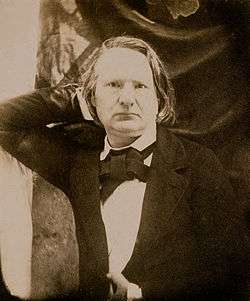
Hugo published his first novel the year following his marriage (Han d'Islande, 1823), and his second three years later (Bug-Jargal, 1826). Between 1829 and 1840, he published five more volumes of poetry (Les Orientales, 1829; Les Feuilles d'automne, 1831; Les Chants du crépuscule, 1835; Les Voix intérieures, 1837; and Les Rayons et les Ombres, 1840), cementing his reputation as one of the greatest elegiac and lyric poets of his time.
Like many young writers of his generation, Hugo was profoundly influenced by François-René de Chateaubriand, the famous figure in the literary movement of Romanticism and France's pre-eminent literary figure during the early 19th century. In his youth, Hugo resolved to be "Chateaubriand or nothing", and his life would come to parallel that of his predecessor in many ways. Like Chateaubriand, Hugo furthered the cause of Romanticism, became involved in politics (though mostly as a champion of Republicanism), and was forced into exile due to his political stances.
The precocious passion and eloquence of Hugo's early work brought success and fame at an early age. His first collection of poetry (Odes et poésies diverses) was published in 1822 when he was only 20 years old and earned him a royal pension from Louis XVIII. Though the poems were admired for their spontaneous fervour and fluency, the collection that followed four years later in 1826 (Odes et Ballades) revealed Hugo to be a great poet, a natural master of lyric and creative song.
Victor Hugo's first mature work of fiction was first published in February 1829 by Charles Gosselin without the author's name and reflected the acute social conscience that would infuse his later work. Le Dernier jour d'un condamné (The Last Day of a Condemned Man) would have a profound influence on later writers such as Albert Camus, Charles Dickens, and Fyodor Dostoyevsky. Claude Gueux, a documentary short story about a real-life murderer who had been executed in France, appeared in 1834 and was later considered by Hugo himself to be a precursor to his great work on social injustice, Les Misérables.
Hugo became the figurehead of the Romantic literary movement with the plays Cromwell (1827) and Hernani (1830).[6] Hernani announced the arrival of French romanticism: performed at the Comédie-Française, it was greeted with several nights of rioting as romantics and traditionalists clashed over the play's deliberate disregard for neo-classical rules. Hugo's popularity as a playwright grew with subsequent plays, such as Marion Delorme (1831), The King Amuses Himself (1832), and Ruy Blas (1838).[7]
Hugo's novel Notre-Dame de Paris (The Hunchback of Notre-Dame) was published in 1831 and quickly translated into other languages across Europe. One of the effects of the novel was to shame the City of Paris into restoring the much-neglected Cathedral of Notre Dame, which was attracting thousands of tourists who had read the popular novel. The book also inspired a renewed appreciation for pre-Renaissance buildings, which thereafter began to be actively preserved.
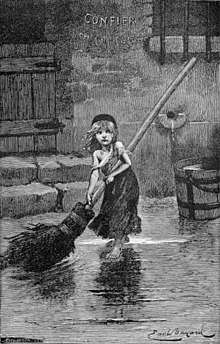
Hugo began planning a major novel about social misery and injustice as early as the 1830s, but a full 17 years were needed for Les Misérables to be realised and finally published in 1862. Hugo had used the departure of prisoners for the Bagne of Toulon in one of his early stories, "Le Dernier Jour d'un condamné" He went to Toulon to visit the Bagne in 1839 and took extensive notes, though he did not start writing the book until 1845. On one of the pages of his notes about the prison, he wrote in large block letters a possible name for his hero: " JEAN TRÉJEAN". When the book was finally written, Tréjean became Jean Valjean.[8]
Hugo was acutely aware of the quality of the novel, as evidenced in a letter he wrote to his publisher, Albert Lacroix, on 23 March 1862, "My conviction is that this book is going to be one of the peaks, if not the crowning point of my work."[9] So publication of Les Misérables went to the highest bidder. The Belgian publishing house Lacroix and Verboeckhoven undertook a marketing campaign unusual for the time, issuing press releases about the work a full six months before the launch. It also initially published only the first part of the novel ("Fantine"), which was launched simultaneously in major cities. Instalments of the book sold out within hours and had enormous impact on French society.
The critical establishment was generally hostile to the novel; Taine found it insincere, Barbey d'Aurevilly complained of its vulgarity, Gustave Flaubert found within it "neither truth nor greatness", the Goncourt brothers lambasted its artificiality, and Baudelaire – despite giving favourable reviews in newspapers – castigated it in private as "repulsive and inept". Les Misérables proved popular enough with the masses that the issues it highlighted were soon on the agenda of the National Assembly of France. Today, the novel remains his most well-known work. It is popular worldwide and has been adapted for cinema, television, and stage shows.
An apocryphal tale[10] about the shortest correspondence in history is said to have been between Hugo and his publisher Hurst and Blackett in 1862. Hugo was on vacation when Les Misérables was published. He queried the reaction to the work by sending a single-character telegram to his publisher, asking ?. The publisher replied with a single ! to indicate its success.[11]
Hugo turned away from social/political issues in his next novel, Les Travailleurs de la Mer (Toilers of the Sea), published in 1866. The book was well received, perhaps due to the previous success of Les Misérables. Dedicated to the channel island of Guernsey, where he spent 15 years of exile, Hugo tells of a man who attempts to win the approval of his beloved's father by rescuing his ship, intentionally marooned by its captain who hopes to escape with a treasure of money it is transporting, through an exhausting battle of human engineering against the force of the sea and a battle against an almost mythical beast of the sea, a giant squid. Superficially an adventure, one of Hugo's biographers calls it a "metaphor for the 19th century–technical progress, creative genius and hard work overcoming the immanent evil of the material world."[12]
The word used in Guernsey to refer to squid (pieuvre, also sometimes applied to octopus) was to enter the French language as a result of its use in the book. Hugo returned to political and social issues in his next novel, L'Homme Qui Rit (The Man Who Laughs), which was published in 1869 and painted a critical picture of the aristocracy. The novel was not as successful as his previous efforts, and Hugo himself began to comment on the growing distance between himself and literary contemporaries such as Flaubert and Émile Zola, whose realist and naturalist novels were now exceeding the popularity of his own work.
His last novel, Quatre-vingt-treize (Ninety-Three), published in 1874, dealt with a subject that Hugo had previously avoided: the Reign of Terror during the French Revolution. Though Hugo's popularity was on the decline at the time of its publication, many now consider Ninety-Three to be a work on par with Hugo's better-known novels.
Political life and exile
| Part of a series on |
| Liberalism |
|---|
 |
|
History
|
|
Ideas
|
|
Schools of thought
|
|
People
|
|
Organizations
|
|
Regional variants
|
|
Related topics
|
|
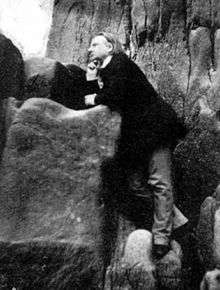
After three unsuccessful attempts, Hugo was finally elected to the Académie française in 1841, solidifying his position in the world of French arts and letters. A group of French academicians, particularly Étienne de Jouy, were fighting against the "romantic evolution" and had managed to delay Victor Hugo's election.[13] Thereafter, he became increasingly involved in French politics.
He was ennobled and elevated to the peerage by King Louis-Philippe in 1845 and entered the Higher Chamber as a pair de France, where he spoke against the death penalty and social injustice, and in favour of freedom of the press and self-government for Poland.
In 1848, Hugo was elected to the National Assembly of the Second Republic as a conservative. In 1849, he broke with the conservatives when he gave a noted speech calling for the end of misery and poverty. Other speeches called for universal suffrage and free education for all children. Hugo's advocacy to abolish the death penalty was renowned internationally.
These parliamentary speeches are published in Œuvres complètes: actes et paroles I : avant l'exil, 1841–1851. Scroll down to the Assemblée Constituante 1848 heading and subsequent pages.[14]
When Louis Napoleon (Napoleon III) seized complete power in 1851, establishing an anti-parliamentary constitution, Hugo openly declared him a traitor to France. He relocated to Brussels, then Jersey, from which he was expelled for supporting a Jersey newspaper that had criticised Queen Victoria and finally settled with his family at Hauteville House in Saint Peter Port, Guernsey, where he would live in exile from October 1855 until 1870.
While in exile, Hugo published his famous political pamphlets against Napoleon III, Napoléon le Petit and Histoire d'un crime. The pamphlets were banned in France but nonetheless had a strong impact there. He also composed or published some of his best work during his period in Guernsey, including Les Misérables, and three widely praised collections of poetry (Les Châtiments, 1853; Les Contemplations, 1856; and La Légende des siècles, 1859).
Like most of his contemporaries, Victor Hugo held colonialist views towards Africans. In a speech delivered on 18 May 1879, he declared that the Mediterranean Sea formed a natural divide between " ultimate civilisation and […] utter barbarism," adding "God offers Africa to Europe. Take it," to civilise its indigenous inhabitants. This might partly explain why in spite of his deep interest and involvement in political matters he remained strangely silent on the Algerian issue. He knew about the atrocities committed by the French Army during the French conquest of Algeria as evidenced by his diary[15] but he never denounced them publicly. A modern reader may also feel puzzled, to say the least, at the meaning of these lines from the conclusion to Le Rhin, chapter 17,[16] published in 1842, twelve years after French troops landed near Algiers.
What France lacks in Algiers is a little barbarity. The Turks [...] knew how to cut heads better than we do. The first thing that strikes savages is not reason but strength. What France lacks, England has it; Russia too.
— Victor Hugo, Le Rhin
However, in Les Misérables, Hugo says the following about the conquering of Algeria:[17]
Algeria too harshly conquered, and, as in the case of India by the English, with more barbarism than civilization.
— Victor Hugo, Les Misérables
Before being exiled he never denounced slavery, and no trace of its abolition is to be found in the 27 April 1848 entry of his detailed diary.
On the other hand, Victor Hugo fought a lifelong battle for the abolition of the death penalty as a novelist, diarist, and member of Parliament. The Last Day of a Condemned Man published in 1829 analyses the pangs of a man awaiting execution; several entries of Things Seen (Choses vues), the diary he kept between 1830 and 1885, convey his firm condemnation of what he regarded as a barbaric sentence;[18] on 15 September 1848, seven months after the Revolution of 1848, he delivered a speech before the Assembly and concluded, "You have overthrown the throne. […] Now overthrow the scaffold."[19] His influence was credited in the removal of the death penalty from the constitutions of Geneva, Portugal, and Colombia.[20] He had also pleaded for Benito Juárez to spare the recently captured emperor Maximilian I of Mexico but to no avail. His complete archives (published by Pauvert) show also that he wrote a letter asking the United States government, for the sake of their own reputation in the future, to spare John Brown's life, but the letter arrived after Brown was executed.
Although Napoleon III granted an amnesty to all political exiles in 1859, Hugo declined, as it meant he would have to curtail his criticisms of the government. It was only after Napoleon III fell from power and the Third Republic was proclaimed that Hugo finally returned to his homeland in 1870, where he was promptly elected to the National Assembly and the Senate.
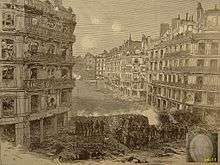
He was in Paris during the siege by the Prussian Army in 1870, famously eating animals given to him by the Paris Zoo. As the siege continued, and food became ever more scarce, he wrote in his diary that he was reduced to "eating the unknown".[21]
During the Paris Commune – the revolutionary government that took power on 18 March 1871 and was toppled on 28 May – Victor Hugo was harshly critical of the atrocities committed on both sides. On 9 April, he wrote in his diary, "In short, this Commune is as idiotic as the National Assembly is ferocious. From both sides, folly."[22] Yet he made a point of offering his support to members of the Commune subjected to brutal repression. He had been in Brussels since 22 March 1871 when in the 27 May issue of the Belgian newspaper l’Indépendance Victor Hugo denounced the government's refusal to grant political asylum to the Communards threatened with imprisonment, banishment or execution.[23] This caused so much uproar that in the evening a mob of fifty to sixty men attempted to force their way into the writer's house shouting " Death to Victor Hugo! Hang him! Death to the scoundrel!"[24]
Victor Hugo, who said "A war between Europeans is a civil war",[25] was an enthusiastic advocate for the creation of the United States of Europe. He expounded his views on the subject in a speech he delivered during the International Peace Congress which took place in Paris in 1849. The Congress, of which Hugo was the President, proved to be an international success, attracting such famous philosophers as Frederic Bastiat, Charles Gilpin, Richard Cobden, and Henry Richard. The conference helped establish Hugo as a prominent public speaker and sparked his international fame, and promoted the idea of the "United States of Europe".[26] On 14 July 1870 he planted the "oak of the United States of Europe" in the garden of Hauteville House where he stayed during his exile on Guernsey from 1856 to 1870. The massacres of Balkan Christians by the Turks in 1876 inspired him to write Pour la Serbie (For Serbia) in his sons' newspaper Le Rappell. This speech is today considered as one of the founding acts of the European ideaI.[27]
Because of his concern for the rights of artists and copyright, he was a founding member of the Association Littéraire et Artistique Internationale, which led to the Berne Convention for the Protection of Literary and Artistic Works. However, in Pauvert's published archives, he states strongly that "any work of art has two authors: the people who confusingly feel something, a creator who translates these feelings, and the people again who consecrate his vision of that feeling. When one of the authors dies, the rights should totally be granted back to the other, the people". He was one of the earlier supporters of the concept of domaine public payant, under which a nominal fee would be charged for copying or performing works in the public domain, and this would go into a common fund dedicated to helping artists, especially young people.
Religious views

Hugo's religious views changed radically over the course of his life. In his youth and under the influence of his mother, he identified as a Catholic and professed respect for Church hierarchy and authority. From there he became a non-practising Catholic and increasingly expressed anti-Catholic and anti-clerical views. He frequented spiritism during his exile (where he participated also in many séances conducted by Madame Delphine de Girardin)[28][29] and in later years settled into a rationalist deism similar to that espoused by Voltaire. A census-taker asked Hugo in 1872 if he was a Catholic, and he replied, "No. A Freethinker".[30]
After 1872, Hugo never lost his antipathy towards the Catholic Church. He felt the Church was indifferent to the plight of the working class under the oppression of the monarchy. Perhaps he also was upset by the frequency with which his work appeared on the Church's list of banned books. Hugo counted 740 attacks on Les Misérables in the Catholic press.[31] When Hugo's sons Charles and François-Victor died, he insisted that they be buried without a crucifix or priest. In his will, he made the same stipulation about his own death and funeral.[32]
Yet he believed in life after death and prayed every single morning and night, convinced as he wrote in The Man Who Laughs that "Thanksgiving has wings and flies to its right destination. Your prayer knows its way better than you do".[33]
Hugo's rationalism can be found in poems such as Torquemada (1869, about religious fanaticism), The Pope (1878, anti-clerical), Religions and Religion (1880, denying the usefulness of churches) and, published posthumously, The End of Satan and God (1886 and 1891 respectively, in which he represents Christianity as a griffin and rationalism as an angel). Vincent van Gogh ascribed the saying "Religions pass away, but God remains", actually by Jules Michelet, to Hugo.[34]
Victor Hugo and music
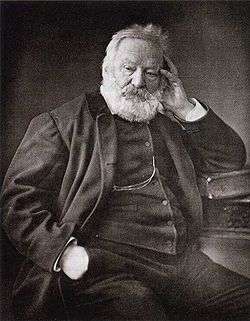
Although Hugo's many talents did not include exceptional musical ability, he nevertheless had a great impact on the music world through the inspiration that his works provided for composers of the 19th and 20th century. Hugo himself particularly enjoyed the music of Gluck and Weber. In Les Misérables, he calls the huntsman's chorus in Weber's Euryanthe, "perhaps the most beautiful piece of music ever composed".[35] He also greatly admired Beethoven, and rather unusually for his time, he also appreciated works by composers from earlier centuries such as Palestrina and Monteverdi.[36]
Two famous musicians of the 19th century were friends of Hugo: Hector Berlioz and Franz Liszt. The latter played Beethoven in Hugo's home, and Hugo joked in a letter to a friend that, thanks to Liszt's piano lessons, he learned how to play a favourite song on the piano – with only one finger. Hugo also worked with composer Louise Bertin, writing the libretto for her 1836 opera La Esmeralda, which was based on the character in The Hunchback of Notre Dame.[36] Although for various reasons the opera closed soon after its fifth performance and is little known today, it has enjoyed a modern revival, both in a piano/song concert version by Liszt at the Festival international Victor Hugo et Égaux 2007[37] and in a full orchestral version presented in July 2008 at Le Festival de Radio France et Montpellier Languedoc-Roussillon.[38]
On the other hand, he had low esteem for Richard Wagner, whom he described as "a man of talent coupled with imbecility.[39]"
Well over one thousand musical compositions have been inspired by Hugo's works from the 19th century until the present day. In particular, Hugo's plays, in which he rejected the rules of classical theatre in favour of romantic drama, attracted the interest of many composers who adapted them into operas. More than one hundred operas are based on Hugo's works and among them are Donizetti's Lucrezia Borgia (1833), Verdi's Rigoletto (1851) and Ernani (1844), and Ponchielli's La Gioconda (1876).[40]
Hugo's novels, as well as his plays, have been a great source of inspiration for musicians, stirring them to create not only opera and ballet but musical theatre such as Notre-Dame de Paris and the ever-popular Les Misérables, London West End's longest running musical. Additionally, Hugo's beautiful poems have attracted an exceptional amount of interest from musicians, and numerous melodies have been based on his poetry by composers such as Berlioz, Bizet, Fauré, Franck, Lalo, Liszt, Massenet, Saint-Saëns, Rachmaninoff, and Wagner.[40]
Today, Hugo's work continues to stimulate musicians to create new compositions. For example, Hugo's novel against capital punishment, The Last Day of a Condemned Man, was adapted into an opera by David Alagna, with a libretto by Frédérico Alagna and premièred by their brother, tenor Roberto Alagna, in 2007.[41] In Guernsey, every two years, the Victor Hugo International Music Festival attracts a wide range of musicians and the premiere of songs specially commissioned from such composers as Guillaume Connesson, Richard Dubugnon, Olivier Kaspar, and Thierry Escaich and based on Hugo's poetry.
Remarkably, not only Hugo's literary production has been the source of inspiration for musical works, but also his political writings have received attention from musicians and have been adapted to music. For instance, in 2009, Italian composer Matteo Sommacal was commissioned by Festival "Bagliori d'autore" and wrote a piece for speaker and chamber ensemble entitled Actes et paroles, with a text elaborated by Chiara Piola Caselli after Victor Hugo's last political speech addressed to the Assemblée législative, "Sur la Revision de la Constitution" (18 July 1851),[42] and premiered in Rome on 19 November 2009, in the auditorium of the Institut français, Centre Saint-Louis, French Embassy to the Holy See, by Piccola Accademia degli Specchi featuring the composer Matthias Kadar.[43]
Declining years and death
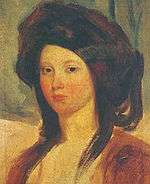
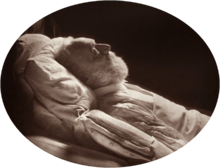
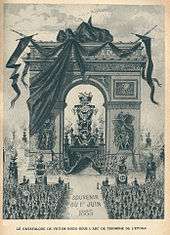
When Hugo returned to Paris in 1870, the country hailed him as a national hero. He was confident that he would be offered the dictatorship, as shown by the notes he kept at the time: "Dictatorship is a crime. This is a crime I am going to commit", but he felt he had to assume that responsibility.[44] Despite his popularity, Hugo lost his bid for re-election to the National Assembly in 1872.
Throughout his life Hugo kept believing in unstoppable humanistic progress. In his last public address on 3 August 1879 he prophesied in an over-optimistic way, "In the twentieth century war will be dead, the scaffold will be dead, hatred will be dead, frontier boundaries will be dead, dogmas will be dead; man will live."[45]
Within a brief period, he suffered a mild stroke, his daughter Adèle was interned in an insane asylum, and his two sons died. (Adèle's biography inspired the movie The Story of Adele H.) His wife Adèle had died in 1868.
His faithful mistress, Juliette Drouet, died in 1883, only two years before his own death. Despite his personal loss, Hugo remained committed to the cause of political change. On 30 January 1876, he was elected to the newly created Senate. This last phase of his political career was considered a failure. Hugo was a maverick and achieved little in the Senate.
Hugo suffered a mild stroke on 27 June 1878.[46][47] To honour the fact that he was entering his 80th year, one of the greatest tributes to a living writer was held. The celebrations began on 25 June 1881, when Hugo was presented with a Sèvres vase, the traditional gift for sovereigns. On 27 June, one of the largest parades in French history was held.
Marchers stretched from the Avenue d'Eylau, where the author was living, down the Champs-Élysées, and all the way to the centre of Paris. The paraders marched for six hours past Hugo as he sat at the window at his house. Every inch and detail of the event was for Hugo; the official guides even wore cornflowers as an allusion to Fantine's song in Les Misérables. On 28 June, the city of Paris changed the name of the Avenue d'Eylau to Avenue Victor-Hugo.[48] Letters addressed to the author were from then on labelled "To Mister Victor Hugo, In his avenue, Paris".
Two days before dying, he left a note with these last words: "To love is to act".
On 20 May 1885, le Petit Journal published the official medical bulletin on Hugo's health condition. "The illustrious patient" was fully conscious and aware that there was no hope for him. They also reported from a reliable source that at one point in the night he had whispered the following Alexandrin, "En moi c’est le combat du jour et de la nuit" – "In me, this is the battle between day and night".[49] Le Matin published a slightly different version, "Here is the battle between day and night."
Hugo's death from pneumonia on 22 May 1885, at the age of 83, generated intense national mourning. He was not only revered as a towering figure in literature, he was a statesman who shaped the Third Republic and democracy in France. All his life he remained a defender of liberty, equality and fraternity as well as an adamant champion of French culture. In 1877, aged 75, he wrote, "I am not one of these sweet-tempered old men. I am still exasperated and violent. I shout and I feel indignant and I cry. Woe to anyone who harms France! I do declare I will die a fanatic patriot.[50]"
Although he had requested a pauper's funeral he was awarded a state funeral by decree of President Jules Grévy. More than two million people joined his funeral procession in Paris from the Arc de Triomphe to the Panthéon, where he was buried. He shares a crypt within the Panthéon with Alexandre Dumas and Émile Zola. Most large French towns and cities have a street or square named after him.
Hugo left five sentences as his last will, to be officially published:
Je donne cinquante mille francs aux pauvres. Je veux être enterré dans leur corbillard.
Je refuse l'oraison de toutes les Églises. Je demande une prière à toutes les âmes.
Je crois en Dieu.
"I leave 50,000 francs to the poor. I wish to be buried in their hearse.
I refuse [funeral] orations from all Churches. I ask all souls for a prayer.
I believe in God."
Drawings
Hugo produced more than 4,000 drawings. Originally pursued as a casual hobby, drawing became more important to Hugo shortly before his exile when he made the decision to stop writing to devote himself to politics. Drawing became his exclusive creative outlet between 1848 and 1851.
Hugo worked only on paper, and on a small scale; usually in dark brown or black pen-and-ink wash, sometimes with touches of white, and rarely with colour. The surviving drawings are surprisingly accomplished and "modern" in their style and execution, foreshadowing the experimental techniques of Surrealism and Abstract expressionism.
He would not hesitate to use his children's stencils, ink blots, puddles and stains, lace impressions, "pliage" or folding (e.g. Rorschach blots), "grattage" or rubbing, often using the charcoal from matchsticks or his fingers instead of pen or brush. Sometimes he would even toss in coffee or soot to get the effects he wanted. It is reported that Hugo often drew with his left hand or without looking at the page, or during Spiritist séances, to access his unconscious mind, a concept only later popularised by Sigmund Freud.
Hugo kept his artwork out of the public eye, fearing it would overshadow his literary work. However, he enjoyed sharing his drawings with his family and friends, often in the form of ornately handmade calling cards, many of which were given as gifts to visitors when he was in political exile. Some of his work was shown to, and appreciated by, contemporary artists such as van Gogh and Delacroix; the latter expressed the opinion that if Hugo had decided to become a painter instead of a writer, he would have outshone the artists of their century.
Victor Hugo and women
Wife
Hugo married Adèle Foucher in October 1822. Despite their respective affairs, they lived together for nearly 46 years until she died in August 1868. Hugo, who was still banished from France, was unable to attend her funeral in Villequier where their daughter Léopoldine was buried. From 1830 to 1837 Adèle had an affair with Charles-Augustin Sainte Beuve, a reviewer and writer.[51]
Mistresses
Juliette Drouet
From February 1833 until her death in 1883, Juliette Drouet devoted her whole life to Victor Hugo, who never married her even after his wife died in 1868. He took her on his numerous trips and she followed him in exile on Guernsey. There Hugo rented a house for her near Hauteville House, his family home. She wrote some 20,000 letters in which she expressed her passion or vented her jealousy on her womanizing lover.[52] On 25 September 1870 during the Siege of Paris (19 September 1870 – 28 January 1871) Hugo feared the worst. He left his children a note reading as follows :
"J.D. She saved my life in December 1851. For me she underwent exile. Never has her soul forsaken mine. Let those who have loved me love her. Let those who have loved me respect her. She is my widow." V.H[53]
Léonie d’Aunet
For more than seven years, Léonie d’Aunet, who was a married woman, was involved in a love relationship with Hugo. Both were caught in adultery on 5 July 1845. Hugo, who had been a Member of the Chamber of Peers since April, avoided condemnation whereas his mistress had to spend two months in prison and six in a convent. Many years after their separation, Hugo made a point of supporting her financially.[54]
Casual affairs
Hugo gave free rein to his sensuality until a few weeks before his death. He sought a wide variety of women of all ages, be they courtesans, actresses, prostitutes, admirers, servants or revolutionaries like Louise Michel for sexual activity. Both a graphomaniac and erotomaniac, he systematically reported his casual affairs using his own code, as Samuel Pepys did, to make sure they would remain secret. For instance, he resorted to Latin abbreviations (osc. for kisses) or to Spanish (Misma. Mismas cosas : The same. Same things). Homophones are frequent : Seins (Breasts) becomes Saint; Poële (Stove) actually refers to Poils (Pubic hair). Analogy also enabled him to conceal the real meaning: A woman's Suisses (Swiss) are her breasts – due to the fact that Switzerland is renowned for its milk. After a rendezvous with a young woman named Laetitia he would write Joie (Happiness) in his diary. If he added t.n. (toute nue) he meant she stripped naked in front of him. The initials S.B. discovered in November 1875 may refer to Sarah Bernhardt.[55]
Gallery
 Crépuscule ("Twilight"), Jersey, 1853–1855.
Crépuscule ("Twilight"), Jersey, 1853–1855. Ville avec le pont de Tumbledown, ("Town with Tumbledown Bridge"), 1847.
Ville avec le pont de Tumbledown, ("Town with Tumbledown Bridge"), 1847. Pieuvre avec les initiales V.H., ("Octopus with the initials V.H."), 1866.
Pieuvre avec les initiales V.H., ("Octopus with the initials V.H."), 1866.- Le Rocher de l'Ermitage dans un paysage imaginaire ("Ermitage Rock in an imaginary landscape")
 Le phare ("The Lighthouse")
Le phare ("The Lighthouse") Gavroche a onze ans, ("Gavroche at eleven years old").
Gavroche a onze ans, ("Gavroche at eleven years old").
Memorials

The people of Guernsey erected a statue by sculptor Jean Boucher in Candie Gardens (Saint Peter Port) to commemorate his stay in the islands. The City of Paris has preserved his residences Hauteville House, Guernsey, and 6, Place des Vosges, Paris, as museums. The house where he stayed in Vianden, Luxembourg, in 1871 has also become a commemorative museum.
Hugo is venerated as a saint in the Vietnamese religion of Cao Đài, in the front hall of the Holy See in Tây Ninh.[56][57]
The Avenue Victor-Hugo in the 16th arrondissement of Paris bears Hugo's name and links the Place de l'Étoile to the vicinity of the Bois de Boulogne by way of the Place Victor-Hugo. This square is served by a Paris Métro stop also named in his honour. In the town of Béziers there is a main street, a school, hospital and several cafés named after Hugo, and a number of streets and avenues throughout France are named after him. The school Lycée Victor Hugo was founded in his town of birth, Besançon in France. Avenue Victor-Hugo, located in Shawinigan, Quebec, was named to honour him. A street in San Francisco, Hugo Street, is named for him.[58]
In the city of Avellino, Italy, Victor Hugo lived briefly stayed in what is now known as Il Palazzo Culturale when reuniting with his father, Leopold Sigisbert Hugo, in 1808. Hugo would later write about his brief stay here, quoting "C'était un palais de marbre..." ("It was a palace of marble").
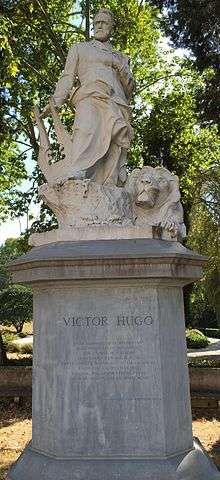
There is a statue of Hugo across from the Museo Carlo Bilotti in Rome, Italy.
Victor Hugo is the namesake of the city of Hugoton, Kansas.[59]
In Havana, Cuba, there is a park named after him.
A bust of Hugo stands near the entrance of the Old Summer Palace in Beijing.
A mosaic commemorating Hugo is located on the ceiling of the Thomas Jefferson Building of the Library of Congress.
The London and North Western Railway named a 'Prince of Wales' Class 4-6-0 No 1134 after Hugo. British Railways perpetuated this memorial, naming Class 92 Electric Unit 92001 after him.
Religious veneration
Thanks to his contribution to mankind, his virtues, and belief in God, he is venerated as a saint in Cao Đài, a new religion established in Vietnam in 1926. According to religious records, he was assigned by God to lead the foreign mission as part of God's Divine hierarchy. He represented mankind, along with the major Saints Sun Yat-sen and Trạng Trình Nguyễn Bỉnh Khiêm, to sign a religious pact with God, promising to lead mankind to "Love and Justice" ("Amour et Justice").
Here is an excerpt of his teaching about heaven:
In all heavens, beauty reigns,
Its beings possess much of divinity.
Peace and harmony rule these realms,
Their beings know not the word 'war'.[60]
Works
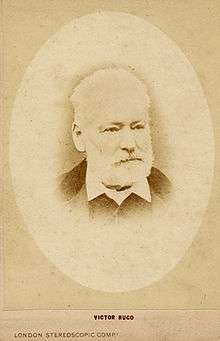
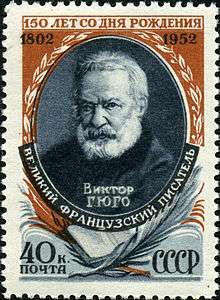
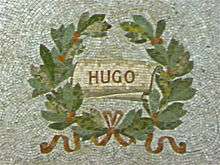
Published during Hugo's lifetime
- Cromwell preface only (1819)
- Odes et poésies diverses (1822)
- Odes (1823)
- Han d'Islande (1823), (Hans of Iceland)
- Nouvelles Odes (1824)
- Bug-Jargal (1826)
- Odes et Ballades (1826), (Odes and Ballads)
- Cromwell (1827)
- Les Orientales (1829), (Orientalia)
- Le Dernier jour d'un condamné (1829), (The Last Day of a Condemned Man)
- Hernani (1830)
- Notre-Dame de Paris (1831), (The Hunchback of Notre-Dame)
- Marion de Lorme (1831)
- Les Feuilles d'automne (1831), (Autumn Leaves)
- Le roi s'amuse (1832)
- Lucrezia Borgia (1833)
- Marie Tudor (1833)
- Littérature et philosophie mêlées (1834), (A Blend of Literature and Philosophy)
- Claude Gueux (1834)
- Angelo, Tyrant of Padua (1835)
- Les Chants du crépuscule (1835), (Songs of the Half Light)
- La Esmeralda (only libretto of an opera written by Victor Hugo himself) (1836)
- Les Voix intérieures (1837)
- Ruy Blas (1838)
- Les Rayons et les Ombres (1840)
- Le Rhin (1842)
- Les Burgraves (1843)
- Napoléon le Petit (1852), (Napoleon the Little)
- Les Châtiments (1853)
- Les Contemplations (1856), (The Contemplations)
- Les TRYNE (1856)
- La Légende des siècles (1859), (The Legend of the Ages)
- Les Misérables (1862)
- William Shakespeare (1864)
- Les Chansons des rues et des bois (1865), (Songs of Street and Wood)
- Les Travailleurs de la Mer (1866), (Toilers of the Sea)
- La voix de Guernsey (1867)
- L'Homme qui rit (1869), (The Man Who Laughs)
- L'Année terrible (1872)
- Quatrevingt-treize (Ninety-Three) (1874)
- Mes Fils (1874)
- Actes et paroles – Avant l'exil (1875)
- Actes et paroles – Pendant l'exil (1875), (Deeds and Words)
- Actes et paroles – Depuis l'exil (1876)
- La Légende des Siècles 2e série (1877)
- L'Art d'être grand-père (1877), (The Art of Being a Grandfather)
- Histoire d'un crime 1re partie (1877), (History of a Crime)
- Histoire d'un crime 2e partie (1878)
- Le Pape (1878)
- La Pitié suprême (1879)
- Religions et religion (1880), (Religions and Religion)
- L'Âne (1880)
- Les Quatres vents de l'esprit (1881), (The Four Winds of the Spirit)
- Torquemada (1882)
- La Légende des siècles Tome III (1883)
- L'Archipel de la Manche (1883)
Poems of Victor Hugo
Published posthumously
- Théâtre en liberté (1886)
- La Fin de Satan (1886)
- Choses vues (1887)
- Toute la lyre (1888), (The Whole Lyre)
- Amy Robsart (1889)
- Les Jumeaux (1889)
- Actes et Paroles – Depuis l'exil, 1876–1885 (1889)
- Alpes et Pyrénées (1890), (Alps and Pyrenees)
- Dieu (1891)
- France et Belgique (1892)
- Toute la lyre – dernière série (1893)
- Les fromages (1895)
- Correspondences – Tome I (1896)
- Correspondences – Tome II (1898)
- Les années funestes (1898)
- Choses vues – nouvelle série (1900)
- Post-scriptum de ma vie (1901)
- Dernière Gerbe (1902)
- Mille francs de récompense (1934)
- Océan. Tas de pierres (1942)
- L'Intervention (1951)
- Conversations with Eternity (1998)
References
- Escholier, Raymond, Victor Hugo raconté par ceux qui l'ont vu, Librairie Stock, 1931, p. 11.
- Bellos, David (2017). The Novel of the Century : The extraordinary adventure of Les Miserables. Particular Books. p. 162. ISBN 978-1-846-14470-7.
- Behr, Edward (1993). The Complete Book of Les Misérables. Arcade Publishing. p. 8.
- Josephson, Matthew (2006). Victor Hugo: A Realistic Biography of the Great Romantic. Jorge Pinto Books, Inc. p. 4.
- Victor Hugo, tome 1: Je suis une force qui va by Max Gallo, pub. Broché (2001)
- State Library of Victoria. "Victor Hugo: Les Misérables – From Page to Stage research guide". Archived from the original on 14 July 2014.
- Brockett, Oscar G. History of the Theatre. Eight Edition. Boston: Allyn & Bacon, 1999. P. 339.
- Le Bagne de Toulon (1748–1873), Académie du Var, Autres Temps Editions (2010), ISBN 978-2-84521-394-4
- "Les Misérables de Victor Hugo". alalettre.com. Retrieved 3 April 2017.
- Garson O'Toole, "Briefest Correspondence: Question Mark? Exclamation Mark!" (14 June 2014).
- Norris McWhirter (1981). Guinness Book of World Records: 1981 Edition. Bantam Books, p. 216.
- Robb, Graham (1997). Victor Hugo: A Biography. W.W. Norton & Company. p. 414.
- On the role of E. de Jouy against V.Hugo, see Les aventures militaires, littéraires et autres de Etienne de Jouy de l'Académie française by Michel Faul (Editions Seguier, France, 2009 ISBN 978-2-84049-556-7)
- "Victor Hugo: Les Misérables – From Page to Stage research guide". State Library of Victoria.
- Hugo, Victor (1972). Choses Vues. Paris: Gallimard. pp. 286–87. ISBN 2-07-040217-7.
- Hugo, Victor. "Le Rhin". Wikisource.org. Retrieved 31 January 2017.
- Les Misérables, Random House Publishing Group, 2000, 1280 pages, ISBN 9780679641551, p. 720.
- Hugo, Victor (1972). Choses vues. Paris: Gallimard. pp. 267–69. ISBN 2-07-040217-7.
- Hugo, Victor (15 September 1848). "Speech on the death penalty". Wikisource.org. Retrieved 31 January 2017.
- "Victor Hugo, l'homme océan". Bibliothèque nationale de France. Retrieved 19 July 2012.
- "Victor Hugo's diary tells how Parisians dined on zoo animals". The Spokesman-Review. Spokane, Washington. 7 February 1915. p. 3.
- Hugo, Victor, Choses vues, 1870–1885, Gallimard, 1972, ISBN 2-07-036141-1, p. 164
- Hugo, Victor (1 January 1872). Actes et paroles: 1870–1871–1872. Michel Lévy frères. Retrieved 3 April 2017 – via Internet Archive.
l'indépendance.
- Hugo, Victor, Choses vues, Gallimard, 1972, ISBN 2-07-036141-1, pp. 176–77
- Hugo, Victor, Choses vues, Gallimard, 1972, ISBN 2-07-036141-1, p. 258
- Peace Congress, 2d, Paris, 1849. Report of the proceedings of the second general Peace Congress, held in Paris on the 22nd, 23rd, and 24 August 1849. Compiled from authentic documents under the superintendence of the Peace Congress Committee. London, Charles Gilpin, 1849
- "Bicentenaire de Victor Hugo (1802-2002) - Sénat, French Government". www.senat.fr. no-break space character in
|title=at position 40 (help) - Malgras, J. (1906). Les Pionniers du Spiritisme en France: Documents pour la formation d'un livre d'Or des Sciences Psychiques. Paris.
- Chez Victor Hugo. Les tables tournantes de Jersey. Extracts from meeting minutes published by Gustave Simon in 1923
- Gjelten, Tom (2008). Bacardi and the Long Fight for Cuba. Penguin. p. 48.
- Robb, Graham (1997). Victor Hugo. London: Picador. p. 32.
- Petrucelli, Alan (2009). Morbid Curiosity: The Disturbing Demises of the Famous and Infamous. Penguin. p. 152.
- Hugo, Victor, The Man Who Laughs, CreateSpace Independent Publishing Platform, 2014, ISBN 978-1495441936, p. 132
- "Vincent van Gogh to Theo van Gogh. The Hague, between about Wednesday, 13 & about Monday, 18 December 1882". Van Gogh Museum. Retrieved 31 January 2012.
- Hugo, V., Les misérables, Volume 2, Penguin Books, 1 December 1980, p. 103.
- "Hugo à l'Opéra", ed. Arnaud Laster, L'Avant-Scène Opéra, no. 208 (2002).
- Cette page use des cadres Archived 8 May 2008 at the Wayback Machine. Festival international Victor Hugo et Égaux. Retrieved 19 July 2012.
- "Mercredi 23 juillet – 20h – Opéra Berlioz / Le Corum". Archived from the original on 9 May 2008. Retrieved 13 April 2008.CS1 maint: BOT: original-url status unknown (link)
- Hugo, Victor, Choses vues, 1870–1885, Gallimard, 1972, p. 353, ISBN 2-07-036141-1
- "Hugo et la musique" in Pleins feux sur Victor Hugo, Arnaud Laster, Comédie-Française (1981)
- "Festival Victor Hugo & Egaux 2008". Archived from the original on 29 April 2008.
- V. Hugo, Actes et paroles: Avant l'exile, 1875, Discours à l’Assemblée législative 1849–1851, J. Hetzel, Maison Quantin, Paris, 1875
- C. Pulsoni, "L'orazione di Victor Hugo trasformata in musica", Il Corriere dell'Umbria, Vivere d'Umbria, Perugia (IT), 19 November 2009
- Hugo Victor, Choses vues, 1870–1885, Gallimard, 1972, 2-07-036141-1, p. 257.
- Victor, Hugo (18 February 2014). "La Fin de Satan: Nouvelle édition augmentée". Arvensa editions. Retrieved 3 April 2017 – via Google Books.
- Robb, Graham Victor Hugo (1997) p. 506
- Liukkonen, Petri. "Victor Hugo". Books and Writers (kirjasto.sci.fi). Finland: Kuusankoski Public Library. Archived from the original on 24 March 2014.
- Acte de décès de Victor Hugo Archived 3 March 2016 at the Wayback Machine
- Le Petit Journal (21 mai 1885), Gallica-BnF, http://gallica.bnf.fr/ark:/12148/bpt6k608676z.item
- Hugo, Victor, Choses vues 1870–1885, Gallimard, 1972, ISBN 2-07-036141-1, p. 411
- Foucher-Hugo Adèle, Victor Hugo raconté par Adèle Hugo, Plon, 1985, 861 p., ISBN 2259012884, p. 41.
- Guillemin, Henri, Hugo, Seuil, 1978, 191 p. ISBN 2020000016, p. 55
- Seghers, Pierre, Victor Hugo visionnaire, Robert Laffont, 95 p., ISBN 2221010442, p. 10.
- Hugo, Victor, Choses vues 1849–1885, Gallimard, 1972, 1014 pp., ISBN 2070402177, p. 857 (17 Sep 1876)
- Hugo, Victor, Choses vues 1870–1885, 529 p., ISBN 2070361411, pp. 371, 521 (n. 1).
- Hoskins, Janet Alison (2015). The Divine Eye and the Diaspora: Vietnamese Syncretism Becomes Transpacific Caodaism. pp. 2, 10, 36–37, 99–103, 189–90. ISBN 978-0-8248-5140-8.
- "Caodaism: A Vietnamese-centred religion". Retrieved 8 May 2009.
- The Chronicle 12 April 1987 p.6
- Gannett, Henry (1905). The Origin of Certain Place Names in the United States. United States Government Publishing Office. pp. 163.
- Gobron, Gabriel. History and Philosophy of Vietnam. Wildside Press. p. 53. ISBN 1434462846.
Further reading
- Afran, Charles (1997). “Victor Hugo: French Dramatist”. Website: Discover France. (Originally published in Grolier Multimedia Encyclopedia, 1997, v.9.0.1.) Retrieved November 2005.
- Azurmendi, Joxe, (1985). Victor Hugo Euskal Herrian, Jakin, 37: 137–66. Website: Jakingunea.
- Bates, Alfred (1906). “Victor Hugo”. Website: Theatre History. (Originally published in The Drama: Its History, Literature and Influence on Civilization, vol. 9. ed. Alfred Bates. London: Historical Publishing Company, 1906. pp. 11–13.) Retrieved November 2005.
- Bates, Alfred (1906). “Hernani”. Website: Theatre History. (Originally published in The Drama: Its History, Literature and Influence on Civilization, vol. 9. ed. Alfred Bates. London: Historical Publishing Company, 1906. pp. 20–23.) Retrieved November 2005.
- Bates, Alfred (1906). “Hugo's Cromwell”. Website: Theatre History. (Originally published in The Drama: Its History, Literature and Influence on Civilization, vol. 9. ed. Alfred Bates. London: Historical Publishing Company, 1906. pp. 18–19.) Retrieved November 2005.
- Bittleston, Misha. "Drawings of Victor Hugo". Website: Misha Bittleston. Retrieved November 2005.
- Burnham, I.G. (1896). "Amy Robsart". Website: Theatre History. (Originally published in Victor Hugo: Dramas. Philadelphia: The Rittenhouse Press, 1896. pp. 203–06, 401–02.) Retrieved November 2005.
- Columbia Encyclopedia, 6th Edition (2001–05). "Hugo, Victor Marie, Vicomte". Website: Bartleby, Great Books Online. Retrieved November 2005. Retrieved November 2005.
- Haine, W. Scott (1997). "Victor Hugo". Encyclopedia of 1848 Revolutions. Website: Ohio University. Retrieved November 2005.
- Karlins, N.F. (1998). "Octopus With the Initials V.H." Website: ArtNet. Retrieved November 2005.
- Liukkonen, Petri (2000). Petri Liukkonen. "Victor Hugo". Books and Writers
- Meyer, Ronald Bruce (2004). Victor Hugo at the Wayback Machine (archived 8 May 2006). Website: Ronald Bruce Meyer. Retrieved November 2005.
- Portasio, Manoel (2009). "Victor Hugo e o Espiritismo". Website: Sir William Crookes Spiritist Society. (Portuguese) Retrieved August 2010.
- Robb, Graham (1997). "A Sabre in the Night". Website: The New York Times (Books). (Excerpt from Graham, Robb (1997). Victor Hugo: A Biography. New York: W.W. Norton & Company.) Retrieved November 2005.
- Roche, Isabel (2005). "Victor Hugo: Biography". Meet the Writers. Website: Barnes & Noble. (From the Barnes & Noble Classics edition of The Hunchback of Notre Dame, 2005.) Retrieved November 2005.
- Schneider, Maria do Carmo M (2010). "Victor Hugo, gênio sem fronteiras". Website: MiniWeb Educacao. (Portuguese) Retrieved August 2010.
- State Library of Victoria (2014). "Victor Hugo: Les Misérables – From Page to Stage". Website: Retrieved July 2014.
- Uncited author. "Victor Hugo". Website: Spartacus Educational. Retrieved November 2005.
- Uncited author. "Timeline of Victor Hugo". Website: BBC. Retrieved November 2005.
- Uncited author. (2000–2005). "Victor Hugo". Website: The Literature Network. Retrieved November 2005.
- Uncited author. "Hugo Caricature". Website: Présence de la Littérature a l'école. Retrieved November 2005.
- Barbou, Alfred (1882). Victor Hugo and His Times. University Press of the Pacific: 2001 paperback edition. ISBN 0-89875-478-X
- Barnett, Marva A., ed. (2009). Victor Hugo on Things That Matter: A Reader. New Haven, Connecticut: Yale University Press. ISBN 0-300-12245-4
- Brombert, Victor H. (1984). Victor Hugo and the Visionary Novel. Boston: Harvard University Press. ISBN 0-674-93550-0
- Davidson, A.F. (1912). Victor Hugo: His Life and Work. University Press of the Pacific: 2003 paperback edition. ISBN 1-4102-0778-1
- Dow, Leslie Smith (1993). Adele Hugo: La Miserable. Fredericton: Goose Lane Editions. ISBN 0-86492-168-3
- Falkayn, David (2001). Guide to the Life, Times, and Works of Victor Hugo. University Press of the Pacific. ISBN 0-89875-465-8
- Feller, Martin (1988). Der Dichter in der Politik. Victor Hugo und der Deutsch-Französische Krieg von 1870/71. Untersuchungen zum französischen Deutschlandbild und zu Hugos Rezeption in Deutschland. Marburg: Doctoral Dissertation.
- Frey, John Andrew (1999). A Victor Hugo Encyclopedia. Greenwood Press. ISBN 0-313-29896-3
- Grant, Elliot (1946). The Career of Victor Hugo. Harvard University Press. Out of print.
- Halsall, A.W. et al. (1998). Victor Hugo and the Romantic Drama. University of Toronto Press. ISBN 0-8020-4322-4
- Hart, Simon Allen (2004). Lady in the Shadows: The Life and Times of Julie Drouet, Mistress, Companion and Muse to Victor Hugo. Publish American. ISBN 1-4137-1133-2
- Houston, John Porter (1975). Victor Hugo. New York: Twayne Publishers. ISBN 0-8057-2443-5
- Hovasse, Jean-Marc (2001), Victor Hugo: Avant l'exil. Paris: Fayard. ISBN 2-213-61094-0
- Hovasse, Jean-Marc (2008), Victor Hugo: Pendant l'exil I. Paris: Fayard. ISBN 2-213-62078-4
- Ireson, J.C. (1997). Victor Hugo: A Companion to His Poetry. Clarendon Press. ISBN 0-19-815799-1
- Maurois, Andre (1956). Olympio: The Life of Victor Hugo. New York: Harper & Brothers.
- Maurois, Andre (1966). Victor Hugo and His World. London: Thames and Hudson. Out of print.
- O'Neill, J, ed. (2000). Romanticism & the school of nature : nineteenth-century drawings and paintings from the Karen B. Cohen collection. New York: Metropolitan Museum of Art. (contains information on Hugo's drawings)
- Robb, Graham (1997). Victor Hugo: A Biography. W.W. Norton & Company: 1999 paperback edition. ISBN 0-393-31899-0, (description/reviews at wwnorton.com)
External links
| Wikimedia Commons has media related to Victor Hugo. |
| Wikiquote has quotations related to: Victor Hugo |
| Wikisource has original works written by or about: Victor Hugo |
- Victor Hugo at the Encyclopædia Britannica
- Two poems by Victor Hugo, Cordite Poetry Review
- France of Victor Hugo
- Guernsey's official Victor Hugo website
- Guernsey's Victor Hugo International Music Festival
- Victor Hugo Central
- Victor Hugo's works: text, concordances and frequency lists
- Les Misérables at CliffsNotes.com
- Victor Hugo le dessinateur
- Official site of the Société des Amis de Victor Hugo
- Official site of the Festival international Victor Hugo et Égaux
- Victor Hugo at the Internet Book List
- Portrait of Victor Hugo at the University of Michigan Museum of Art
- Study of Victor Hugo for 'Le panorama du siècle', (Panorama of the Century) by Alfred Stevens at University of Michigan Museum of Art
Online works
- Works by Victor Hugo at Project Gutenberg
- Works by Victor Hugo at Faded Page (Canada)
- Works by or about Victor Hugo at Internet Archive
- Works by Victor Hugo at LibriVox (public domain audiobooks)

- Works by Victor Hugo at Open Library
- English translation of Hugo's At Dawn Tomorrow (Demain, dès l'aube)
- Translation of Victor Hugo note found in Hunchback of Notre Dame, french edition
- Les Voix intérieures – at athena.unige.ch (in French)
- Translation of The legend of Victor Hugo by Paul Lafargue
- The Century Was Two Years Old : Victor Hugo The Lilly Library, Bloomington IN